Convention Center UpgradesMay 20, 2021
These Renovated Convention Centers Are Attracting Planners and Attendees By Christine LoomisConvention Center Upgrades
These Renovated Convention Centers Are Attracting Planners and Attendees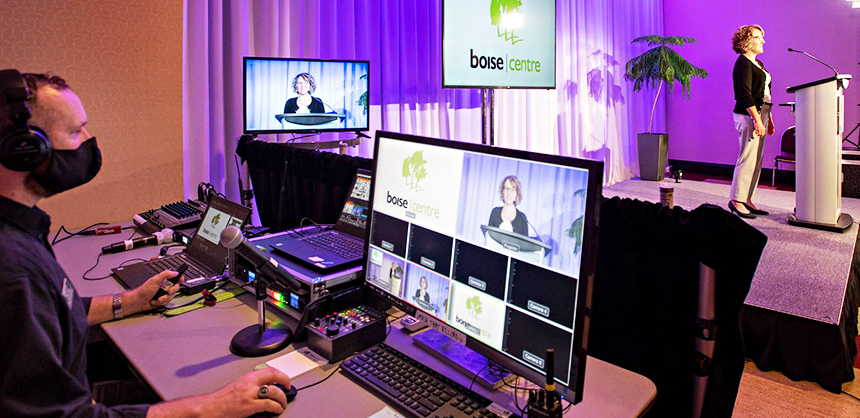
At the Boise Centre, a $47.5 million expansion added nine meeting rooms, a 14,000-sf ballroom and a new Executive Boardroom, bringing the center’s total space to 86,000 sf.
Considering the ongoing explosion of technological advances and ever-evolving design preferences, it doesn’t take long for venues critical to the meetings industry to become out of date. It’s not surprising that convention centers are often in update mode, from increasing technological capabilities and sustainability to upgrading culinary offerings, changing lighting and décor and adding meeting space, among other things.
Sometimes the impetus is to bring new business to a city, including larger conventions that need more space than current square footage allows. Often it’s that, but also a desire to meet the needs of an important current client that’s outgrowing the space.
Las Vegas, Nevada
The Las Vegas Convention Center is a good example of the latter, and the Consumer Electronic Show (CES) is one client the city and the Las Vegas Convention and Visitors Authority (LVCVA) want to accommodate — with good reason. CES brought 170,000 attendees to its January meeting held last year before the COVID-19 lockdowns, and sold out the city’s 150,000 hotel rooms. This year’s CES was an all-digital format, while organizers hope for at least the same attendance in 2022 as they had in 2020.
LVCVA stated early on that the goal was to complete construction of the convention center expansion in time for CES 2021. While the 2021 event was all online, the convention center expansion is now complete and it’s prepared for events, including CES 2022. “The expansion [is] critical to the growth of CES,” says Karen Chupka, E.V.P., CES, with the Consumer Technology Association (CTA), which puts on the show. “The expansion allows CES to grow strategically and provide our attendees with state-of-the-art facilities. As new trends emerge and the industry continues to evolve, CES can remain at the forefront of the future of business and technology.”
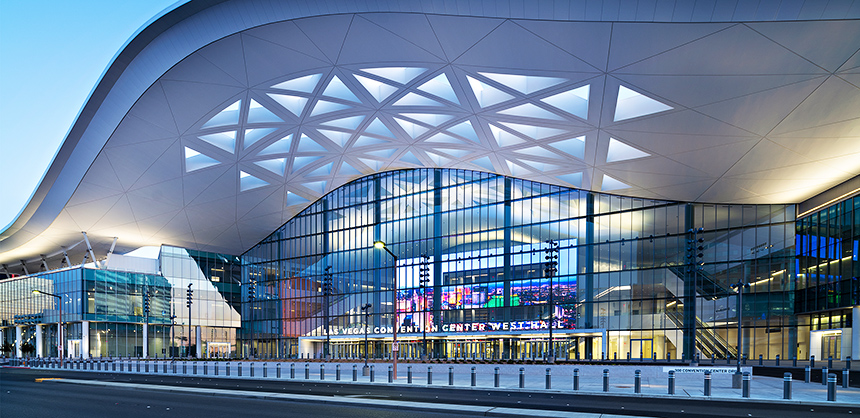
The Las Vegas Convention Center’s West Hall.
CES has been meeting at the Las Vegas Convention Center since 1978, and Chupka says it has been a wonderful home to CES. But, the expansion was needed. “The new expansion and renovation [connects] all facility halls, [will provide] our exhibitors and attendees with an overall better experience and [will deliver] on our promise that CES is the global stage for innovation.”
But it’s not just about the convention center. It’s also about the hotels, the city and the LVCVA. “We’re also excited that Las Vegas will continue to add to its 150,000 guest rooms over the next several years,” Chupka adds. “CTA contracts with more than 45 Las Vegas hotels to secure discounted room rates during CES. Most attendees and exhibitors book directly, selling out the city’s 150,000 rooms, making CES a truly city-wide event.”
Of the city, Chupka says, “Las Vegas is a world-class business destination that ensures a truly unforgettable experience for our customers every year. Its appeal is that it has world-class hotels, restaurants and entertainment, and operates 24 hours a day. It offers visitors options for how they spend their down time.”
It’s something of an understatement to say that the city and LVCVA go above and beyond. “We continuously work with the LVCVA to promote both Las Vegas and CES to our international business audience, and our partnership with Las Vegas and designation as the World Trade Center Las Vegas helps attract that audience to the city for CES and throughout the year,” Chupka says. “During the week of CES, airlines added nearly 20,000 seats from locations all over the world to help bring more visitors to Las Vegas. Very few cities or airports would have the capacity to take on such a lift for a one-week period.”
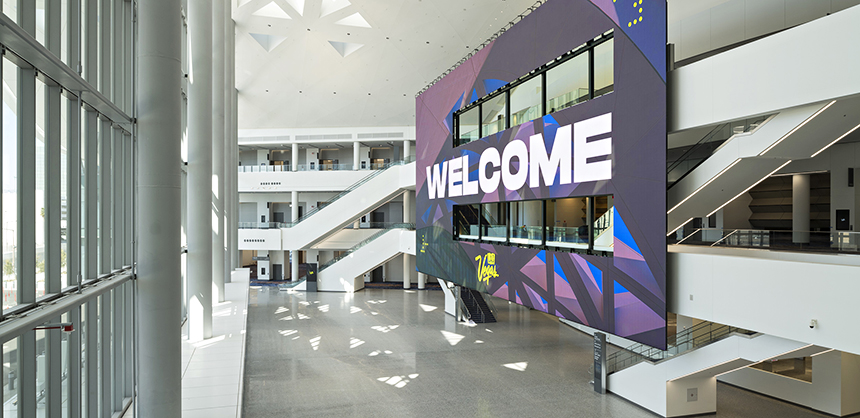
The Las Vegas Convention Center’s West Hall expansion was completed earlier this year.
The convention center’s comprehensive 1.4 million sf expansion includes the 600,000-sf West Hall. The expansion wrapped up earlier this year, while renovation of the existing 3.2 million-sf convention center is slated for 2024 completion. “The LVCVA, along with all our official show venues, are wonderful, engaged partners and critical in ensuring we provide an extraordinary experience to our customers each year,” Chupka says. “We’re excited that the renovation and expansion will provide upgraded services for our customers.”
San Francisco, California
Groups that have experienced San Francisco’s George R. Moscone Convention Center before and after its renovation and expansion see the changes as very positive. Bill Lynch, CEM, and president, Specialty Food Association, is very familiar with the center. The group’s Winter Fancy Food Show early last year drew 30,000 industry professionals. “The SFA Winter Fancy Food Show used up just about every nook and cranny in the building, everything from the exhibit halls to ballrooms, to flex-spaces, and some usage of the terrace, although we have bigger plans in the future for that,” Lynch says. He adds that among the highly positive changes was, “The transition from a conventional space for traditional pipe-and-drape exhibits to multi-dimensional and flexible-space options that opened up many opportunities to deliver value for our show participants.”
Additionally, Lynch notes that while some good things are new, some have always been. “Flow was dramatically improved now that the space has been opened up and connected. Wi-Fi is always great at Moscone, and the catering staff continues to amaze us with their creativity and innovation, which is hard to do for a show that’s all about food creativity and innovation.” As for show attendees, Lynch adds, “They loved how open and bright it is, along with how easy it is now to navigate the building, whether that be through the connected space on Level 1 or the airbridge across Howard Street.” Bottom line, Lynch says, “We were just thrilled with how well the new space lent itself to creating more opportunities for connection, learning and showcasing what’s next in food.”
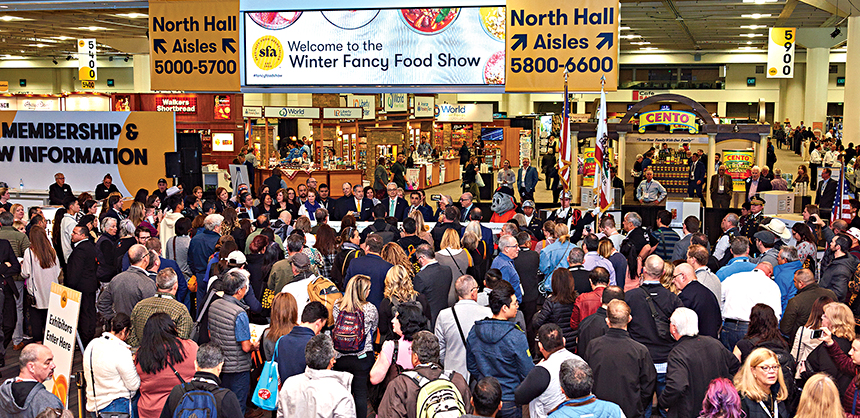
The Specialty Food Association’s Winter Fancy Food Show drew 30,000 industry professionals to the George R. Moscone Convention Center early last year.
There’s a reason the City of San Francisco works particularly well for this group. “San Francisco is the hotbed for food innovation on the West Coast, and the Bay Area is home to an extremely dense population of specialty food makers and buyers,” Lynch says. But it’s not just the synergy with the industry. “San Francisco has always been progressive with commuting options, so as our reliance on shuttles has reduced, the service level provided by organizations like Uber and Lyft have made our participants’ experience an easy and enjoyable one. The hotel community around Moscone Center is also so great that most of our attendees are within walking distance,” he adds. “We have long-standing relationships with the great hotel community in San Francisco and continue to be impressed by the new properties that come online.”
To planners considering San Francisco, Lynch says, ”If your organization is looking for a world-class experience from the start of the planning process through the post-show debrief, you will not be disappointed with the level of care the San Francisco Travel Association and Moscone Center staff show you.”
While the center is closed temporarily due to the pandemic, Gov. Gavin Newsom has announced that the state plans to fully reopen in June.
Portland, Oregon
A center under renovation might be a barrier for some groups in terms of booking during that time period, but it shouldn’t necessarily be so. It may surprise planners to know that meeting during a renovation can actually be a non-issue. Oregon Convention Center (OCC) in Portland, Oregon, wrapped up its renovation in late 2019, and the new adjacent Hyatt Regency Portland at the Oregon Convention Center opened shortly afterward. The American Distilling Institute held its annual Craft Spirits Conference at the OCC, with 1,800 in attendance, about halfway through the renovation.
Even during the convention center’s renovations, Portland and the OCC was a great fit for this group. “The American Distilling Institute is the largest and oldest trade organization in the growing craft distilling industry. The annual convention has a reputation for delivering an exceptional combination of educational sessions, trade shows and networking,” says Anne-Sophie Whitehead, deputy director & conference director for the institute. “Our group is composed of awesome, creative individuals who pursue a dream to bring quality products to the world. We look for affordable, creative cities with a vibrant food, cocktail and spirits scene to make the annual gathering a place where participants can afford to attend with their staff and invest in a lasting impact for their growth.”
She points out that Oregon is home to more than 70 craft distilleries, about a dozen in Portland itself, adding, “The food and beer scenes are also thriving, and its laid-back attitude make it an ideal location for our attendees. The ability of attendees to drive from nearby Washington state, which has an even larger craft spirits scene, and other nearby states, was also a plus, as was the airlift for our foreign attendees.”
Better yet, Whitehead says the renovations had no impact on the conference in terms of noise or aesthetics. “I don’t think attendees realized there was a renovation going on. We didn’t see an impact on the freight bays and truck traffic either. The center was very pleasant to walk around, full of natural light, which was appreciated in late winter. Our layout was very compact, so the need for signage was minimal once we had directed attendees through the best entrance door.”
That said, she thinks the renovations to the plaza make it easier for attendees to find the right door and stay away from the street. “We also had no issue with traffic around the convention center, or delays for people getting in,” Whitehead adds. “The parking at the convention center was plentiful for us, and I believe we had a flat rate negotiated ahead of time for our attendees.”
The convention center is not located downtown, a consideration for attendees who likely want to experience all that downtown Portland offers, as the Institute’s attendees do. For that reason, the group used the DoubleTree by Hilton Hotel, a short walk from the convention center, as well as the Hilton Portland Downtown. “The closest large hotel to the convention center at the time was the DoubleTree. Initially, we were concerned about the brand popularity and the location away from downtown, but we were thrilled with the property and staff,” Whitehead says. “The vast majority of people opted to stay near the convention center and Uber or take the light rail to downtown, so were pleased we made it easy for them to have options.”
That’s where Travel Portland came in. “The CVB helped us figure out how to offer free rail passes to our attendees and market the 15-minute ride to and from downtown,” Whitehead says. Even during renovation, she says there were no issues with move in/out, budget, A/V or catering, or anything to do with the center itself. “Our main challenge is always planning within the legal restrictions for our industry,” she says. “The hotel F&B and sales team were very helpful in discussing with the person on the ground, the liquor board and helping to arrange deliveries for us. The CVB worked with us.”
Another thing that Whitehead says she appreciated were the frequent check-ins from convention center staff to make sure all the group’s needs were met. “Whatever the need, they knew who to reach out to get a fast fix and were empowered to take action. They also all seemed to know the building very well and enjoy their colleagues,” she says. “I don’t recall having to dial our sales or convention manager during that show because our banquet manager or his/her staff would notice we needed help and radio ahead. Management made rounds several times a day as well. Oregon Convention Center’s well-trained, personable and professional staff is a big part of why we’ll be looking at Portland again, with an eye for the improvements.”
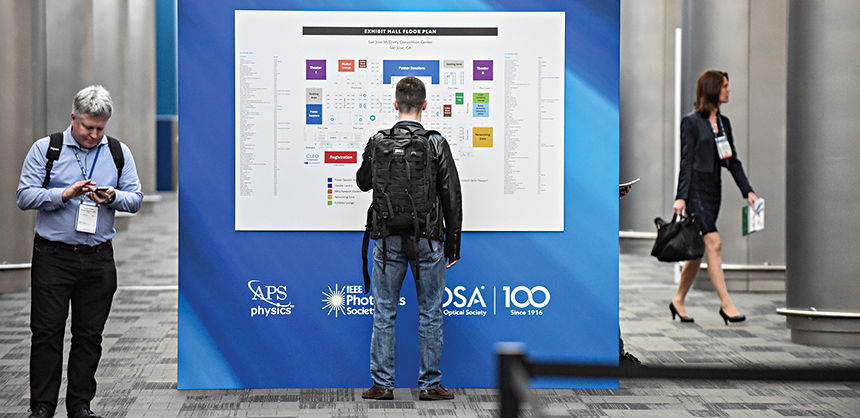
The San Jose McEnery Convention Center has repeatedly been the site of the CLEO Conference. Kimberly L. Coerr, senior meeting manager for the conference, says San Jose is a “natural home” for their event.
San Jose, California
San Jose McEnery Convention Center (SJMCC) remains the go-to convention facility for many groups in the tech industry, in part because it’s always evolving and upgrading. Prior to the pandemic lockdowns, for example. a major A/V upgrade was implemented.
CLEO is the world’s premier international forum dedicated to providing education on innovative advances, research and new technologies from the laser science industry. It has repeatedly booked San Jose. “San Jose is the capital of Silicon Valley, and the proximity to tech leaders and industry innovators makes San Jose a natural home for our conference of scientists, researchers and innovators,” says Kimberly L. Coerr, senior meeting manager for the CLEO conference, which draws nearly 4,000 for its annual conference.
The group remains dedicated to San Jose, which says a lot about the power of the destination for tech events. “We use the convention center,” Coerr says. “Most of the meeting space we’ve used is on one level, which made directional flow easy and kept the energy alive with the attendees. We do have to use space at both the Marriott and the Hilton, which adds to the event budget, since there is not all the space we need at the convention center.” A plus is that the center is not too overwhelming, she adds. “We definitely take over the whole building and appreciate not feeling like we’re a small fish in a big pond.”
Another positive is the area. “I think the area around the SJMCC is fantastic for places to walk,” Coerr says. “Everything is within easy walking distance. A half-mile walk gets you to all the hotels, bars, restaurants and shops. In addition, there’s great public transportation. We don’t really need to use shuttles.” She’s heard no complaints from conference staff or attendees about move in/out, and doesn’t recall any unexpected fees. “Budget-wise, it helps to have such fast Wi-Fi included in the costs,” she says. “And the Wi-Fi was great — it works very well and as advertised.”
Coerr also has praise for Visit San Jose, the city’s CVB. “The CVB has been very helpful in acting as our advocate to the hotels and community in San Jose,” she says. “They value our business, and when we run into challenges, they’re willing to listen and find solutions.” To any planner considering San Jose, Coerr advises, “Take time to walk around the community; explore the dining and shopping options, and take in some community events. There’s a special culture and energy in San Jose, and becoming familiar with that allows you to communicate that message to your potential attendees.”
Louisville, Kentucky
Heading east, Kentucky International Convention Center (KICC) in Louisville, Kentucky, underwent a two-year, $207 million renovation and expansion that increased space by more than a third, to 200,125 sf, and added a ballroom, new meeting rooms and a 175-seat conference theater. The center also achieved LEED Silver certification.
Among other amenities at the center, Blake Henry, general manager, Kentucky Venues, for the center, points to the upgraded technology as a draw for planners, including a “state-of-the-art” conference theater with built-in teleconferencing capabilities and digital displays, and 40,000 sf of new ballroom space with LED walls. “Our facility’s award-winning renovations give meeting planners the flexibility and options they need to craft a meeting that raises the bar for future events,” he says.
Planners who don’t know Louisville will also find plenty to like in the walkability of the area around KICC and what the city has to offer. “Stepping outside of the venue, attendees will be greeted by friendly neighbors that call Louisville home,” Henry says. “KICC has authentic attractions and experiences within walking distance, including nationally recognized foodie destinations, bourbon distillery experiences, museums and more than 3,000 hotel rooms.”
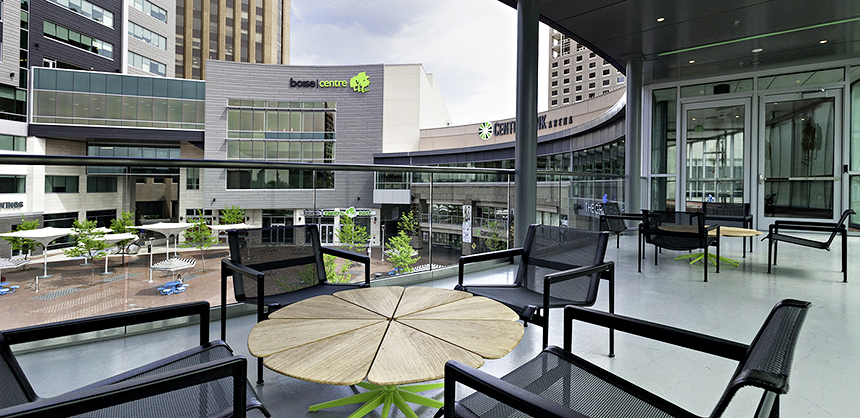
At the Boise Centre, a $47.5 million expansion added nine meeting rooms, a 14,000-sf ballroom and a new Executive Boardroom, bringing the center’s total space to 86,000 sf.
Around the Country
At the Boise Centre, a $47.5 million expansion added nine meeting rooms, a 14,000-sf ballroom and a new Executive Boardroom, bringing the total events space to 86,000 sf. Its largest function room is more than 24,000 sf. The center also recently received the coveted GBAC STAR facility accreditation, the gold standard for cleaning, disinfection and infectious disease prevention. The center — Idaho’s largest convention center — is the first business and event facility in the state to earn the accreditation. In addition, there are more than 100 restaurants and microbreweries within a six-block area, and nine hotels with a combined 1,300 rooms within walking distance.
The center also offers state-of-the-art video conferencing and technology to meet the needs of any virtual or hybrid event. Services include: a fully customizable event studio on-site, complete with staging, backdrop, lighting and cameras; the ability to stream presentations, live video and content to multiple meeting rooms on-site, and across the globe. The technology is ideal for conferences, breakout sessions, keynote speakers, workshops and board meetings.
At Pocono Manor in Pennsylvania’s Pocono Mountains, Kalahari Resorts & Conventions has nearly doubled its meeting space by adding 105,000 sf, 18 new meeting rooms and a new, 38,000-sf main ballroom, in addition to the existing 25,000-sf ballroom. A new junior ballroom is also added to the mix. The property now also features an exclusive executive conference center for up to 400 guests.
The Memphis Convention Center, now called the Renasant Convention Center, just completed a “top-to-bottom” $200 million renovation. It now offers a 118,000-sf, column-free exhibit hall — the largest in the region — with flexible space, natural light and river views.
The Washington State Convention Center in Seattle is adding 1.4 million sf at a cost of $1.7 billion. The new Summit building will be one block from the existing WSCC building, creating a campus. The expected opening is 2022.
Bottom line: Associations and groups of all sizes and industries can find a convention center to meet their needs — many of them with upgraded spaces and amenities, or even a completely new footprint. | AC&F |








